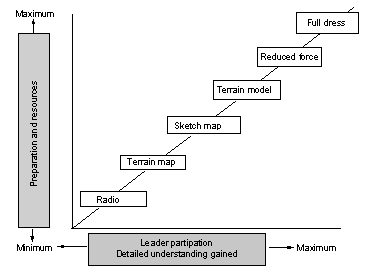Breaching Rehearsals
FM 101-5 gives a complete discussion of rehearsals, including types, techniques, and responsibilities. This chapter specifically discusses breaching rehearsals and considerations when conducting breaching rehearsals.
Planning
4-1. Rehearsals do not just happen; they must be well-planned. Successful rehearsals minimize the cost of time and maximize the understanding of the plan. Units may use a WO to establish responsibilities for preparing the rehearsal site. The WO can also identify battle drills that subordinate units should rehearse to prepare for the upcoming breaching operation. Units should include a complete rehearsal plan with an operation order (OPORD). The rehearsal plan may include a separate set of graphics if necessary.
Types
4-2. The five types of rehearsals are—
- Confirmation brief.
- Back brief.
- Combined-arms rehearsal.
- Support rehearsal.
- Battle drill or SOP rehearsal.
The combined-arms rehearsal and the battle drill or SOP rehearsal are most commonly used for breaching operations.
Combined-Arms Rehearsal
4-3. The maneuver unit HQ normally conducts the combined-arms rehearsal, and it is performed after subordinate units have issued their OPORD. The rehearsal ensures that subordinate plans are synchronized with those of other units and that the plans achieve the intent of the higher commander. A combined-arms rehearsal is particularly important when preparing for a complex breaching operation. It is very difficult to synchronize the actions of all the units involved in the operation.
4-4. Units should rehearse each phase of the operation, from the movement to and occupation of SBF positions through the passage of follow-on forces. The rehearsal must ensure that each unit knows how its tasks are integrated into the overall plan, in time and in space. For example, the support force must understand how long the breach force expects the reduction effort to take, so that the support force can ensure that its plan to suppress the enemy is adequate. At the same time, the breach force must understand its relative position to the support force when it is at the obstacle location. This ensures that the breach force, while moving to and reducing the obstacle, does not unnecessarily mask the fires of the support force.
4-5. At a minimum, the following should be addressed during a combined-arms rehearsal:
- The latest information concerning the enemy obstacle system.
- Actions that the higher HQ is taking to assist the breaching operation.
- The time available for emplacing smoke and activating CFZs (include location and duration).
- The criteria for lifting/shifting direct and indirect fires.
- The commitment criteria for the breach force.
- The method used to reduce the obstacle system.
- The marking to be used. One technique is to have a marked lane near the rehearsal site. All participants should view and drive/walk through the marked lane when arriving at or departing from the rehearsal site. The marking system should also be shown at support rehearsals conducted by combat service support (CSS) elements.
- The criteria and signals for the assault force to begin moving to created lanes.
Battle Drill
4-6. A battle drill or an SOP rehearsal ensures that all participants understand techniques and procedures. These rehearsals are used by all echelons; but they are used most extensively by platoons, squads, and sections. For breaching operations, a battle drill or an SOP rehearsal can include lane-marking procedures or dismounted reduction techniques. Rehearsals should be conducted often to reinforce procedures that will be used during the breaching operation.
Techniques
4-7. Rehearsal techniques are limited only by the unit's resourcefulness. Generally, six techniques are used—
Time and resource requirements for these techniques range from extensive to minimal. As the techniques are listed above, each successive one takes a decreasing amount of time and resources to prepare and conduct. Each rehearsal technique provides a different degree of understanding to participants. Figure 4-1 shows the rehearsal techniques relative to time, resourcing, participation, and understanding.
|
|
4-8. When preparing for a breaching operation, use rehearsal techniques that provide the best understanding. Therefore, conduct a full-dress rehearsal if time and resources permit. Regardless of the rehearsal technique used, commanders must ensure that conditions (enemy situation, obstacle composition, visibility) are replicated in a realistic manner. For example, if a breach force is conducting a full-dress rehearsal, it should use the same obstacle system in the rehearsal as the one intelligence indicates that the enemy has emplaced. If intelligence is unavailable, the breach force should use the templated obstacle system. This requires the breach force to apply the same reduction techniques in the rehearsal that will be used during the operation.
4-9. Additionally, it is imperative that high standards be used during rehearsals. The breach force should rehearse proofing and marking obstacles. The assault force must rehearse all aspects of its assault, including the dismounted, ground fight if it is expected during the operation.
